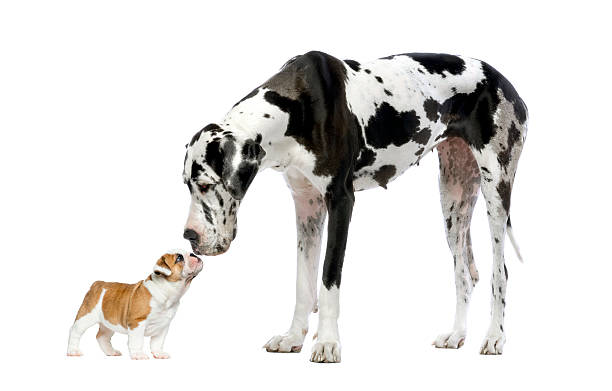Small vs. Large Dogs: Common Health Issues and Lifespan
Dogs come in all shapes and sizes, each with unique health considerations and lifespans. Understanding the common health issues that affect small and large dogs can help pet owners provide better care and improve their furry friends’ quality of life. In this article, we’ll explore the typical health problems associated with small and large dogs and how their sizes impact their life expectancy.
Common Health Issues in Small Dogs:
Small dogs, typically weighing under 25 pounds, have distinct health concerns that owners should be aware of:
- Dental Problems: Due to their small mouths, small dogs are more prone to dental issues, including plaque buildup, tartar, and periodontal disease. Regular brushing and professional cleanings are essential for maintaining good oral health.
- Tracheal Collapse: A common issue in toy breeds, tracheal collapse occurs when the cartilage in the trachea weakens, causing breathing difficulties, coughing, and a honking noise. Managing this condition often requires weight management, medications, and in severe cases, surgery.
- Luxating Patella: Small dogs are susceptible to knee problems, particularly luxating patella, where the kneecap dislocates from its normal position. This can cause lameness and pain, with treatment options ranging from physical therapy to surgery, depending on the severity.
- Hypoglycemia: Smaller dogs, especially puppies, are prone to hypoglycemia or low blood sugar levels. This can lead to weakness, seizures, and even loss of consciousness. Regular, balanced meals and monitoring are crucial to prevent this condition.
- Heart Disease: Small breeds like the Cavalier King Charles Spaniel are at a higher risk of developing heart conditions, such as mitral valve disease. Regular vet check-ups can help detect heart issues early, allowing for better management through diet, exercise, and medication.
Common Health Issues in Large Dogs:
Large dogs, generally weighing over 50 pounds, face a different set of health challenges:
- Hip Dysplasia: One of the most common issues in large breeds, hip dysplasia occurs when the hip joint doesn’t fit together correctly, leading to pain, arthritis, and mobility issues. Early detection and weight management are key, along with possible surgical interventions.
- Bloat (Gastric Dilatation-Volvulus): Large, deep-chested dogs are at risk of bloat, a life-threatening condition where the stomach twists, cutting off blood flow. Symptoms include a swollen abdomen, drooling, and unproductive vomiting. Emergency veterinary care is required to treat bloat.
- Arthritis: Due to their larger size and weight, large dogs are more prone to joint problems and arthritis, especially as they age. Providing joint supplements, maintaining a healthy weight, and regular exercise can help manage this condition.
- Osteosarcoma: Large breeds, like Great Danes and Rottweilers, are at higher risk for bone cancer (osteosarcoma). Early detection is challenging, as symptoms often don’t appear until the cancer has progressed. Treatment typically involves surgery and chemotherapy.
- Heart Conditions: Larger breeds, such as Dobermans and Boxers, are prone to heart issues like dilated cardiomyopathy, where the heart becomes enlarged and functions poorly. Regular heart health checks and monitoring are important for managing these conditions.
Lifespan Differences Between Small and Large Dogs:
One of the most noticeable differences between small and large dogs is their lifespan. Generally, small dogs live longer than large dogs, with the average lifespan of small dogs ranging from 12 to 16 years, while large dogs typically live between 8 to 12 years. Here’s a closer look at why:
- Metabolism and Growth Rate: Small dogs have faster metabolisms but slower growth rates compared to large dogs. Large breeds grow rapidly, which puts more stress on their bones and joints, leading to earlier onset of health issues and a shorter lifespan.
- Genetic Factors: Larger dogs are genetically predisposed to faster aging and early degeneration, contributing to their shorter lifespans. Meanwhile, small dogs have been selectively bred for longevity and resilience.
- Impact of Size on Organ Function: The heart and other organs of large dogs work harder to support their bigger bodies, which can lead to earlier organ failure compared to small dogs. This increased strain on vital organs contributes to their shorter life expectancy.
- Management and Care: The quality of care, including diet, exercise, regular vet visits, and preventative measures, can significantly impact a dog’s lifespan, regardless of size. Small dogs tend to have fewer severe health problems that can be managed more easily, contributing to their longer lives.
Understanding the health issues common to small and large dogs can help pet owners make informed decisions about their care, leading to healthier and happier lives for their pets. While small dogs generally outlive large dogs, being proactive with health management, regular vet check-ups, and providing a balanced diet and adequate exercise can improve the quality of life for dogs of all sizes. Whether you have a tiny Chihuahua or a towering Great Dane, attentive pet care tailored to your dog’s needs will help them live their best life.
